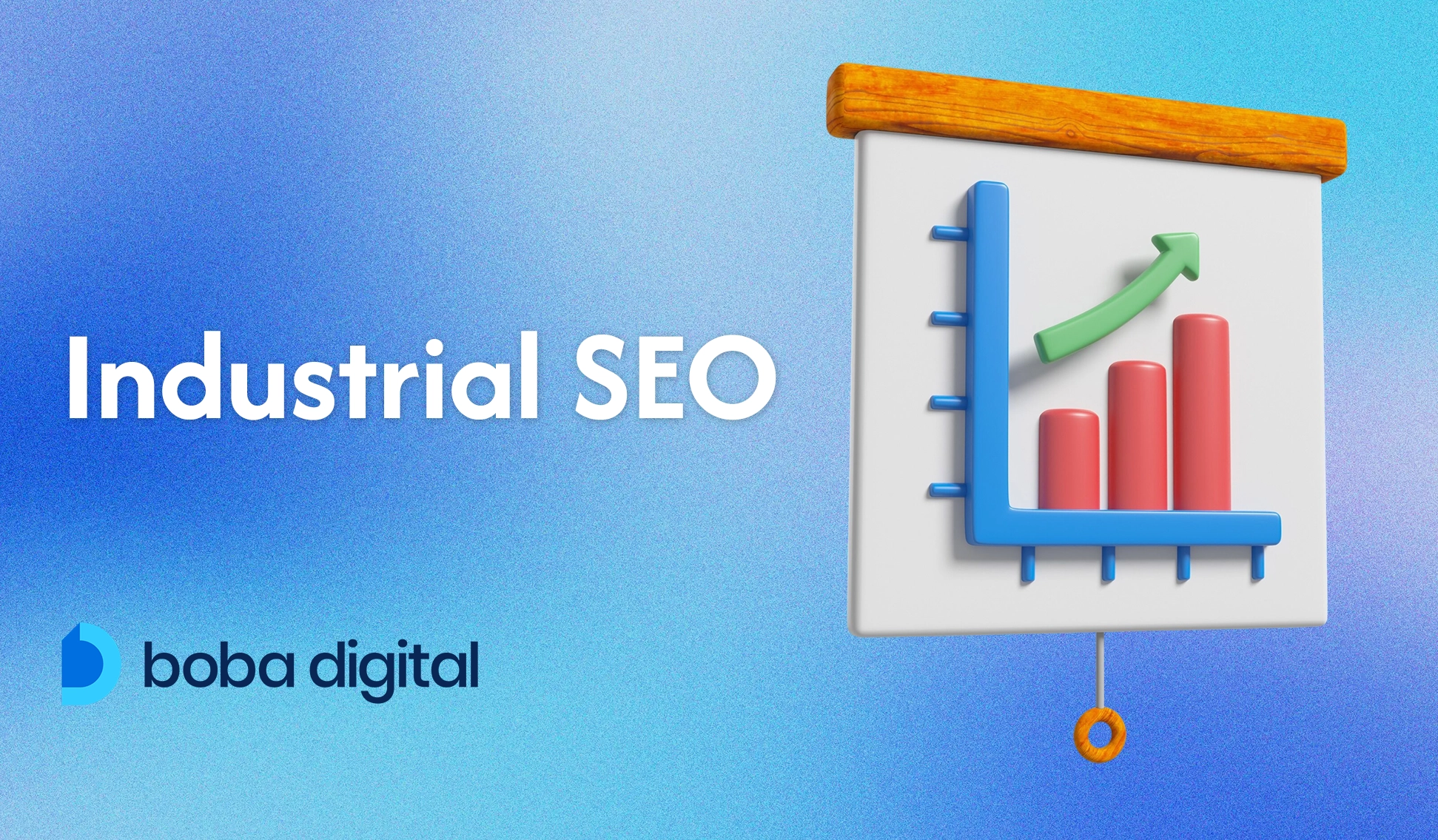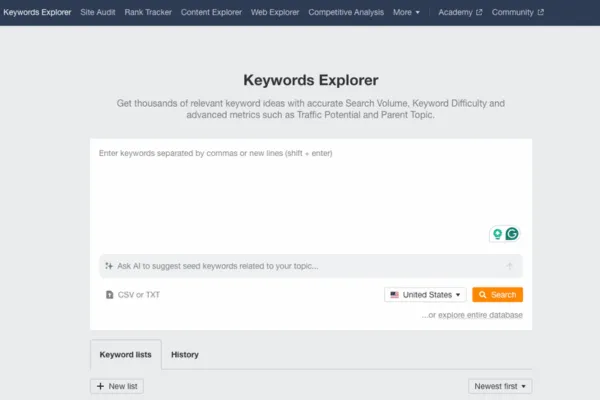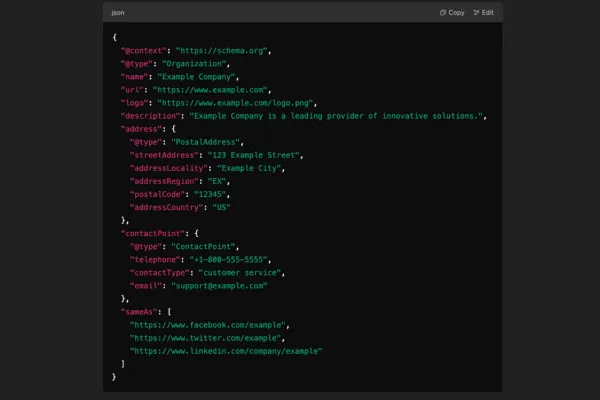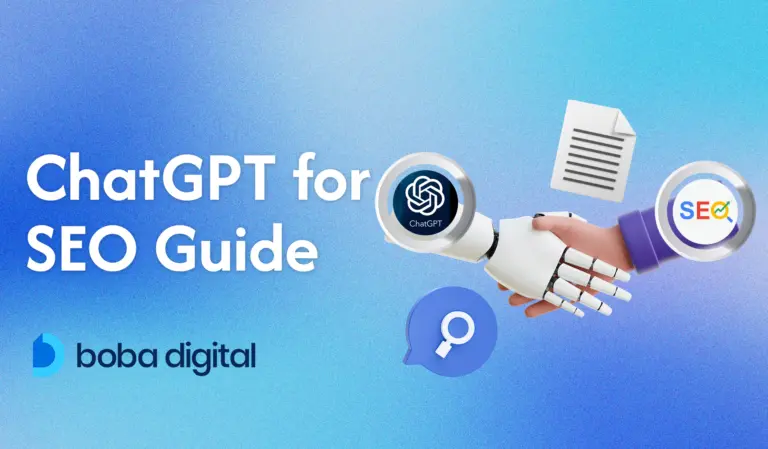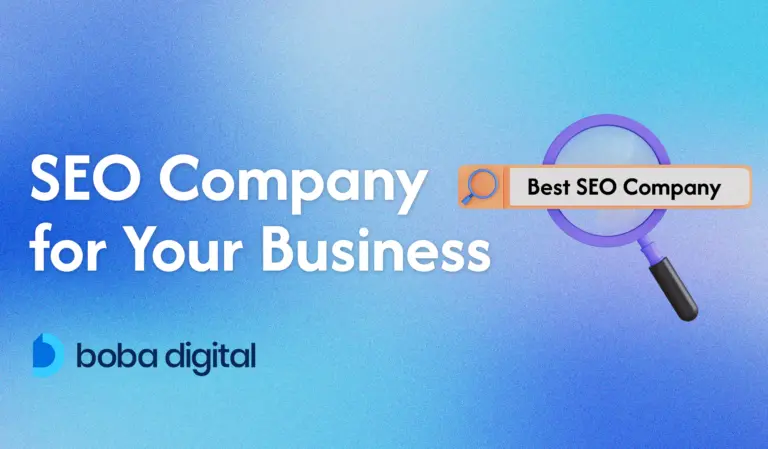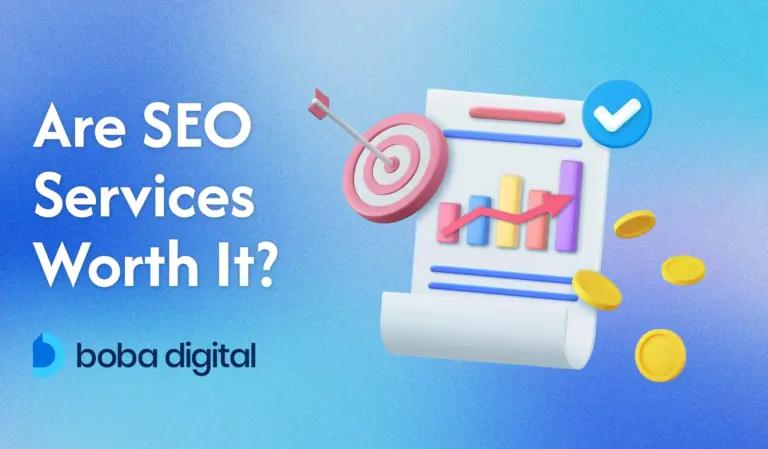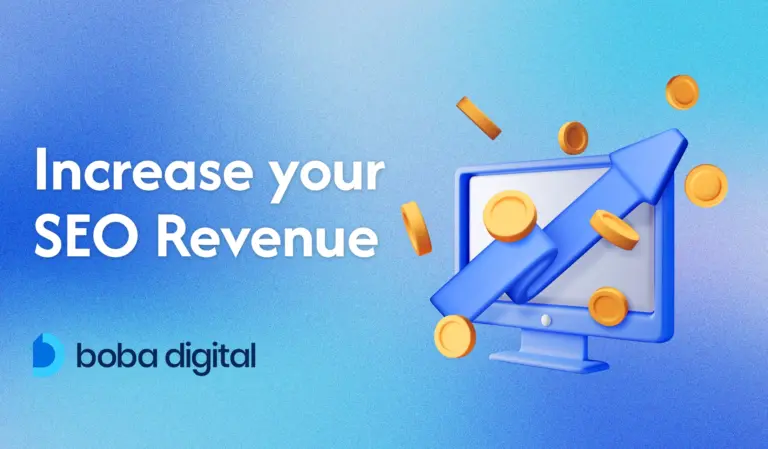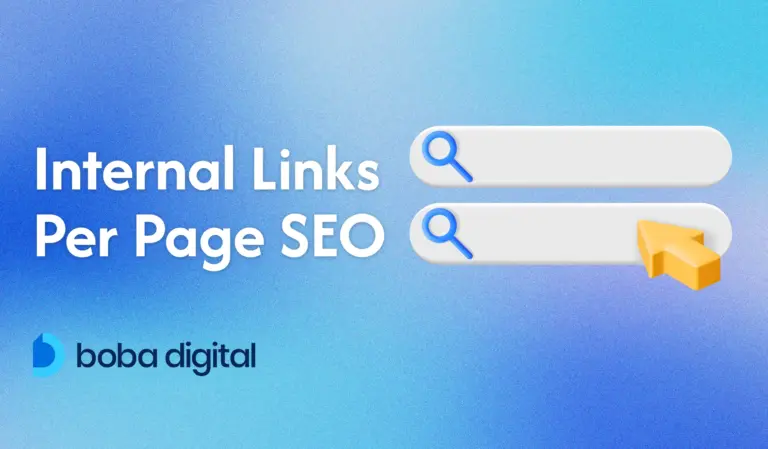Industrial SEO: Expert Guide for Industrial Companies
SEO might sound like just another marketing buzzword, but for industrial companies, it’s the secret sauce to staying ahead in a competitive market. Picture your business ranking at the top of search engine results when potential B2B clients are actively looking for your products or services. That’s not just visibility—it’s the first step toward boosting lead generation and building lasting brand recognition.
With 89% of B2B researchers starting their journey online, mastering SEO isn’t just important; it’s essential. But there’s a difference between generic SEO strategies and those that truly drive results in the industrial sector. That’s where an Industrial SEO strategy comes into play.
This article will guide you through building a powerful Industrial SEO strategy, tailored specifically to meet the unique needs of industrial businesses. Ready to turn your website into a lead-generating machine? Keep reading!
What is Industrial SEO?
Social media boosts your SEO by expanding your content’s reach and visibility, which can lead to more backlinks and increased organic traffic. So, leveraging social platforms is a smart strategy for better search rankings!
Industrial SEO is a tailored search engine optimization strategy designed specifically for manufacturing, construction, and industrial service companies. Unlike general SEO, which targets a broad audience, Industrial SEO zeroes in on B2B clients and emphasizes industry-specific keywords, ensuring businesses appear prominently in search engine results when potential clients search for relevant products or services.
A striking 79% of professionals in the industrial sector already use an SEO strategy, highlighting its critical role in modern, industrial marketing strategy (2022 Manufacturing Survey Insights).
What sets Industrial SEO apart is its focus on long sales cycles and highly technical content. Industrial and manufacturing companies often deal with complex offerings that require more than just standard marketing tactics.
Successful Industrial SEO involves creating in-depth product descriptions, technical case studies, and whitepapers that not only inform but also build trust with potential B2B clients.
Industrial SEO vs. Traditional SEO: Key Differences
| Feature | Industrial SEO | Traditional SEO |
| Target Audience | B2B clients, industry professionals | General consumers, broad audience |
| Content Type | Technical product content, case studies, whitepapers | Blogs, articles, general product descriptions |
| SEO Goals | Lead generation, brand visibility, industry authority | Traffic generation, brand awareness, sales |
| Keyword Strategy | Focus on industry-specific and long-tail keywords | Emphasis on broad and competitive keywords. |
Unlike traditional SEO, which casts a wide net with broad keywords and generic content, Industrial SEO is about precision. It gets deep into niche topics, addressing specific needs and challenges within the industrial sector.
Industrial SEO isn’t just about driving traffic—it’s about attracting the right traffic. And when done correctly, it can transform your website into a lead-generating powerhouse within the industrial market.
5 Key Elements of an Effective Industrial SEO Strategy
Comprehensive Keyword Research
Keyword research is the backbone of any effective Industrial SEO strategy. It helps industrial companies understand what their target audience is searching for and ensures their website appears in relevant search results.
Identifying high-value B2B and industry-specific keywords can attract businesses, qualified leads, improve search engine rankings, and drive more organic search and traffic. Without a well-researched keyword strategy, even the best content may fail to reach the right audience, making keyword research an indispensable part of SEO success.
Content Marketing
When it comes to Industrial SEO, content marketing is more than just filling up a blog page—it’s about delivering real value to your target audience.
Industrial companies can build trust and demonstrate their expertise by producing in-depth resources like case studies, whitepapers, technical blogs, and product guides. Well-crafted, keyword-driven content enhances your brand’s visibility in search engine results while capturing the attention of B2B clients.
The right content can transform your website into a go-to resource, driving relevant traffic and generating more qualified leads.
Local SEO for Industrial Companies
For industrial businesses targeting specific regions, local SEO is a game-changer.
It helps your company show up in local search results when potential customers are looking for industrial products or services in the area.
By focusing on localized content, building local backlinks, and maintaining an active Google Business Profile, you can increase your visibility to nearby leads. Strong local SEO strategies connect your business with the right audience at the right time, driving more relevant traffic and boosting lead generation.
Link Building
To truly elevate your Industrial SEO strategy, link building plays a pivotal role. Think of it as creating a web of trust around your industrial website—it’s not just about collecting links but building meaningful connections with reputable industry sources.
Targeting industry-specific publications, manufacturing directories, and trade association websites, helps you in strengthening your site’s credibility and drive relevant traffic.
These high-quality backlinks act as endorsements, signaling to search engines that your website is an authoritative and trustworthy source. When combined with other SEO efforts, a strong link-building strategy can significantly boost your search engine rankings and enhance your brand’s visibility.
Technical SEO Optimization
Technical SEO is a critical component of Industrial SEO, focusing on the backend elements of a website that influence search engine rankings.
It involves optimizing page speed, ensuring mobile-friendliness, and implementing structured data. These upgrades not only improve user experience but also enable search engines to crawl and index your site more efficiently, increasing your visibility in search engine results pages (SERPs).
How to Do SEO for Industrial Companies: Step-by-Step Strategy?
Step 1: Conduct Industrial-Specific Keyword Research
A successful Industrial SEO strategy begins with smart keyword research, but this isn’t about just keeping up with your competitors—it’s about leading the way. Before getting into keyword gap analysis, consider how your SEO strategy can extend your sales team’s reach and attract your ideal prospects.
This approach ensures your online presence isn’t just visible but also resonates with your target audience.
Use tools like Ahrefs, SEMrush, and Google Keyword Planner to uncover industrial-specific and buyer-intent keywords. Instead of broad terms, focus on targeted phrases like “Precision CNC machining services” or “Custom metal fabrication near me.”
These keywords are not just words—they’re the bridge connecting potential clients to your services.
To refine your strategy, take your keyword list to Google and see which pages currently rank. Analyze these competitors—not just to imitate but to innovate. Look at how their content engages the audience and then aim to create something even more valuable.
Long-tail keywords make up the vast majority of all Google searches (Semrush, 2022). So, prioritizing long-tail keywords, such as “Custom stainless steel manufacturing in Houston,” benefits you by increasing your chances of reaching highly qualified leads who are ready to take action.
Step 2: Optimize Your Industrial Website for SEO
1. Content Optimization
When it comes to Industrial SEO, content optimization is where strategy meets storytelling. It’s not just about adding keywords to your pages but about crafting content that resonates with B2B audiences and answers their specific questions.
In the industrial sector, where purchase decisions are often complex and research-driven, your content should act as a trusted resource, offering clear and valuable insights.
An effective content strategy involves creating focused pages that dig into one topic at a time. Whether it’s building unique pages for each physical location or crafting dedicated content for every product, this approach ensures your site is not only informative but also search engine-friendly. By aligning your content with specific search intents, you increase the chances of appearing in relevant search engine results pages (SERPs).
Beyond keywords, structured data (Schema Markup) is another powerful tool for content optimization. For example, using Product Schema to showcase specifications, pricing, and availability can attract potential buyers directly from search results.
Service Schema, on the other hand, helps highlight your service offerings, coverage areas, and contact details, boosting your local SEO performance.
Content Optimization Tips:
- Do: Create engaging and precise headings that align with search intent.
- Don’t: Mislead with generic titles that fail to match the content.
2. Meta Optimization
Meta optimization is more than just filling in blanks—it’s about creating a powerful first impression on search engine results pages (SERPs).
Meta titles and descriptions serve as your website’s digital storefront, enticing users to click by offering a clear, concise snapshot of what they can expect to find. When optimized correctly, these elements can significantly boost your website’s visibility and click-through rates, contributing to higher search rankings.
Crafting compelling meta titles requires a blend of creativity and strategy. By incorporating primary keywords naturally—like “Industrial Metal Fabrication Services | [Company Name]”—you align with search intent while maintaining a professional and polished presentation.
Keeping titles within the 50-60 character range prevents truncation, ensuring your message remains impactful and complete.
A strong meta description doesn’t just repeat keywords; it engages the reader with a clear call to action. For example: “Discover our precision metal fabrication services. Contact us for a quote today!” Limiting descriptions to 150-160 characters maximizes their effectiveness on SERPs.
For product pages, dynamic meta tags offer an efficient solution. These tags automatically generate unique descriptions by pulling relevant product details, ensuring every product page is optimized without the need for manual updates. This approach not only improves SEO performance but also enhances the user experience by delivering relevant content at every click.
3. Internal Linking
Internal linking is not just about connecting pages—it’s about creating a seamless path for both users and search engines to navigate your site. Well-placed internal links guide visitors to important product, service, and high-value content pages, such as case studies and informative blogs.
For example, a link like “Learn more about our precision CNC machining services” not only directs users to a relevant service page but also strengthens the SEO value of that page.
The key is to use descriptive anchor text that naturally includes target keywords without over-optimization. Avoid repetitive exact-match keywords, as this can do more harm than good for your search engine rankings.
To build a solid internal linking strategy, start with a hierarchical structure. Link from high-authority pages, like your homepage, to deeper pages within your site.
Tools like Ahrefs and SEMrush can help you identify these high-authority pages by analyzing your internal linking structure. By directing internal links to these pages, you can effectively distribute link equity across your site, boosting overall SEO performance and making it easier for search engines to understand your site’s architecture.
4. Permalink Structure Optimization
Permalinks are the permanent URLs that guide users and search engines to your website’s pages. A well-structured permalink not only enhances user experience but also plays a critical role in your site’s SEO performance. Clean, descriptive URLs help search engines understand page content and improve search rankings, while also making your links more shareable and trustworthy.
A good permalink should be clear and concise, reflecting the page’s content and incorporating primary keywords naturally.
For instance, “www.example.com/industrial-machining-services” is far more effective than a generic URL like “www.example.com/p=12345″—the former is not only more professional but also SEO-friendly.
Including primary keywords in permalinks can boost your page’s relevance in search results. However, avoid keyword stuffing, as overly optimized URLs can appear spammy to both users and search engines. Instead, focus on creating URLs that are descriptive and aligned with the page’s content.
Examples of Optimized Permalinks:
- Service Page: “www.example.com/metal-fabrication-services”
- Blog Post: “www.example.com/blog/benefits-of-cnc-machining”
- Product Category: “www.example.com/products/stainless-steel-components”
To keep your URLs evergreen, avoid using dates or dynamic parameters unless necessary. Simple, static URLs are easier to manage and maintain, ensuring that your links remain relevant and effective in the long run.
5. Image Optimization
Image optimization is a critical yet often overlooked element of Industrial SEO. Well-optimized images not only enhance page speed and improve user experience but also contribute to better search engine rankings.
Faster-loading pages reduce bounce rates, keeping potential B2B clients engaged longer on your site.
One of the simplest ways to optimize images is by using descriptive file names before uploading them. Instead of generic names like “IMG_1234.jpg,” use SEO-friendly names such as “industrial-laser-cutting-machine.jpg.” This practice helps search engines understand the image content and improves the chances of appearing in image search results.
Adding alt text to images is another essential step. Alt text provides a written description of the image, aiding SEO and ensuring accessibility for users with visual impairments. For example, an effective alt text for an industrial image could be: “Laser cutting machine performing precision metal fabrication.” This not only adds context but also helps your page rank for relevant keywords.
Image size and format also play a crucial role. Compress images using tools like TinyPNG or ImageOptim to maintain quality while reducing file size, leading to faster page load times. For even smaller file sizes and quicker loading, consider using the WebP format, which offers excellent quality with minimal file weight.
Step 3: Develop High-Quality Content for Industrial SEO
1. Conduct Competitor Analysis to Identify Content Opportunities
To build a robust Industrial SEO strategy, developing high-quality content isn’t just about creating something new—it’s about creating something better.
Competitor analysis is a critical first step, allowing you to see what’s working in your industry and where you can provide greater value.
Start by researching top-performing competitors using tools like Ahrefs, SEMrush, or BuzzSumo. These platforms help identify which pages generate the most organic traffic and which high-value keywords drive that success.
Pay close attention to the depth, accuracy, and engagement of competitor content, including social shares, backlinks, and overall format.
The real opportunity lies in identifying content gaps. Look for unanswered questions, outdated information, or angles your competitors might have missed.
For example, if a competitor ranks well with an article on “Benefits of CNC Machining in Aerospace Manufacturing,” you could take this a step further by developing a more detailed guide. Incorporate real-world examples, updated industry statistics, and engaging visuals to provide a richer, more valuable resource.
2. Create Content that Outperforms Competitors
In the world of Industrial SEO, creating content that merely matches competitors is not enough—you need to outperform them. The goal is to offer more value, deeper insights, and a richer user experience that keeps your audience engaged and coming back for more.
A proven strategy for achieving this is the Skyscraper Technique. This involves identifying high-performing content in your niche and then creating a version that is more comprehensive, engaging, and valuable.
For example, if competitors have a simple blog post on “How to Maintain Industrial Equipment,” you could take it up a notch by developing a full guide. Include a downloadable maintenance checklist, real-world case studies, and a structured maintenance schedule to add practical value.
Visual elements play a critical role in enhancing content quality. Adding infographics, charts, and videos can break up long texts, provide visual explanations, and improve overall readability. This not only boosts user engagement but also increases the chances of earning backlinks, which are vital for SEO performance.
Long-form content, particularly in industrial B2B contexts, can set your brand apart. Articles with 1,500+ words generally perform well because they allow for detailed exploration of complex topics. Providing in-depth knowledge builds trust with your audience and positions your brand as an industry authority.
When you consistently create content that is more informative and user-focused than what is currently available, you not only improve your search engine rankings but also become a go-to resource for your target audience.
3. Advanced SEO Practices for Content Optimization
NLP (Natural Language Processing) Optimization
Incorporating Natural Language Processing (NLP) into your content strategy is a game-changer for Industrial SEO.
NLP helps bridge the gap between how users search and how search engines interpret those queries. By aligning content with Google’s understanding of search intent, you boost the chances of ranking higher for relevant searches.
Tools like SurferSEO and Frase can help seamlessly integrate NLP terms into your content. Instead of focusing solely on exact match keywords, these tools guide you in using related terms, synonyms, and semantic phrases that align with E-E-A-T (Experience, Expertise, Authoritativeness, Trustworthiness).
For example, if your primary keyword is “industrial metal fabrication,” including related terms like “precision machining,” “stainless steel processing,” and “custom metal parts” adds depth and relevance to your content.
Implementing E-E-A-T Tactics for Industrial Content
- Experience: Demonstrate real-world expertise by sharing practical examples, detailed case studies, and customer testimonials. This builds credibility with both search engines and your audience.
- Expertise: Dive deep into technical aspects by providing industry insights, detailed specifications, and actionable how-to guides. The more niche-specific your content, the better it will perform in industrial B2B searches.
- Authoritativeness: Back your content with solid credentials. Mention industry awards, certifications, and professional affiliations to reinforce your brand’s authority in the industrial sector.
- Trustworthiness: Establish trust by including author bios, transparent contact information, and citing credible sources for any data or statistics used. Adding expert quotes or conducting interviews with industry professionals further strengthens your content’s authority.
4. Enhance Internal Linking to Boost SEO Performance
Think of internal linking as creating a roadmap through your industrial website, guiding both users and search engines to your most valuable content.
It’s not just about adding links but about building a well-structured network where every page has a clear purpose and contributes to your site’s overall SEO strategy.
A smart approach is to build a content hub structure, where broad pillar pages connect to more detailed supporting pages and vice versa. This method ensures that your most important pages, like those detailing key services or high-value products, receive the internal link equity they deserve.
For example, a pillar page about “Industrial Metal Fabrication” could naturally link to related topics such as “Precision Metal Parts” or “Custom Automation Solutions.”
When choosing anchor text, aim for clarity and relevance. Instead of generic prompts like “Learn more,” use specific, keyword-rich phrases like “precision metal parts” or “custom automation solutions.” This not only improves SEO but also gives users a clear idea of what to expect when they click.
Internal linking should feel intuitive and help users explore related content without feeling forced. Imagine a blog on “The Benefits of Industrial Automation” seamlessly linking to a service page on “Custom Automation Solutions” and a case study titled “How Automation Increased Efficiency in Manufacturing.” This strategy enhances engagement, keeping visitors on your site longer and guiding them towards conversion opportunities.
Avoid the temptation to over-link. Too many links can overwhelm users and dilute SEO benefits. Instead, focus on creating a balanced, thoughtful internal linking strategy that strengthens your site’s structure and boosts its performance in search engine rankings.
5. Optimize Content with Structured Data and Schema Markup
Structured data and schema markup are like signposts for search engines, helping them understand and display your content more effectively.
For industrial websites, implementing the right schema types can enhance visibility in search engine results pages (SERPs) and improve the chances of showing up in rich snippets.
Schema Types to Implement:
- Product Schema: Highlight important product details such as technical specifications, availability, and pricing. This is particularly useful for industrial products with complex features.
- Service Schema: Provide detailed information about your manufacturing services, including locations, processes, and specific capabilities. This helps local customers find your services easily.
- FAQ Schema: Create quick-answer formats that can appear directly in SERPs, offering users immediate value while boosting your site’s visibility.
Tools like Google’s Structured Data Markup Helper or Schema.org can generate code snippets, making the implementation process straightforward. Once you’ve added schema markup, always validate it using Google’s Rich Results Test to ensure everything is set up correctly.
6. Focus on High-Value Content Types for Industrial SEO
To capture the attention of B2B audiences in the industrial sector, your content strategy needs to go beyond basic blogs and service pages.
High-value content types such as case studies, whitepapers, and product guides can significantly enhance your website’s authority and attract qualified leads.
- Case Studies: Share real-world examples of successful projects, detailing the specific challenges faced and the innovative solutions your company provided. These stories build credibility and help potential clients visualize how your services can address their needs.
- Whitepapers and E-books: Offer in-depth insights into industry trends, technical research, and advanced knowledge. This type of content positions your brand as a thought leader and provides valuable resources that can be used for lead generation through gated content.
- Technical Blogs: Write detailed articles on niche topics like “How to Choose the Right Material for Industrial Parts.” These blogs not only improve your SEO with targeted keywords but also attract industry professionals looking for expert advice.
- Product Guides: Develop comprehensive guides that include product specifications, practical use cases, and maintenance tips. These are particularly effective in converting visitors into leads by answering specific product-related queries.
- Video Content: Create engaging videos that showcase factory tours, demonstrate product use, or offer how-to tutorials. Video content not only enhances user engagement but also broadens your reach through platforms like YouTube and social media.
Step 4: Build High-Quality Backlinks in the Industrial Sector
Backlinks act as endorsements from other websites, indicating to search engines that your content is trustworthy and valuable.
Each high-quality backlink contributes to your site’s domain authority, helping it rank higher in search engine results, especially for competitive B2B queries.
For industrial companies, securing backlinks from reputable industry sources—such as trade publications, manufacturing directories, and authoritative blogs—positions your brand as a trusted industry leader. These links not only improve SEO performance but also drive targeted traffic from potential clients actively searching for reliable suppliers and service providers.
Let’s find out why backlinks matter, how they enhance your own website traffic’s authority, and the best practices for acquiring valuable links within the industrial sector.
1. Directory Listings in Industrial and Manufacturing Directories
Getting your industrial business listed in authoritative directories is a smart way to build high-quality backlinks and boost your brand’s visibility. Well-known directories like ThomasNet, GlobalSpec, and IndustryNet are trusted resources where B2B clients often search for specific products or services.
These directory listings not only provide valuable referral traffic but also help enhance your website’s domain authority, contributing to better search engine rankings.
Additionally, if your business targets specific geographic areas, directory listings can support local SEO by linking back to your site with localized keywords, increasing your visibility in regional searches.
Being featured on these reputable platforms reinforces your business’s credibility as a reliable supplier and can drive targeted leads from industry professionals actively seeking partnerships and solutions.
2. Guest Posting on Industry-Relevant Websites
Guest posting on well-known industry websites isn’t just a link-building tactic—it’s a strategic move to elevate your brand’s credibility and connect with a highly targeted audience.
When your insights appear on manufacturing blogs, trade publications, or industrial forums, they serve as a testament to your expertise and reinforce your brand’s presence in the sector.
Sharing valuable content through guest posts offers a chance to showcase your knowledge while gaining high-quality backlinks from reputable sources.
Articles such as “The Benefits of CNC Machining for the Automotive Sector” or “How to Choose the Right Industrial Equipment for Your Facility” do more than boost SEO—they position your company as a thought leader with practical insights that address real-world challenges.
This strategy also builds a bridge between your brand and potential B2B clients. When your expertise is featured consistently in respected publications, it sends a clear message that your business is not only knowledgeable but also an active contributor to industry conversations.
As your brand’s voice becomes more recognized, your company transforms from being just another name in the market to a trusted resource within the industrial community.
4. Securing Links from Manufacturing and B2B Resource Pages
When it comes to building high-quality backlinks, manufacturing, and B2B resource pages are often untapped goldmines. These pages curate valuable links and tools for specific industries, making them a natural fit for promoting your business while enhancing your website’s SEO performance.
Unlike random backlinks, links from reputable resource pages signal to search engines that your site is a trusted resource, boosting your domain authority and search engine rankings.
Finding the right resource pages requires a bit of creativity and strategic searching. Using advanced search operators like “inurl:resources + industrial suppliers” or “intitle:useful links + manufacturing services” can help uncover pages that align with your industry. Once identified, these pages present an opportunity to showcase your brand as a relevant and valuable resource.
The next step is crafting a professional yet approachable outreach message. When reaching out, focus on how your content or service complements their resource page. A well-structured template can make all the difference:
“Hi [Name],
I came across your resource page and noticed it offers valuable insights for the industrial sector. I believe our [Guide/Tool/Service] could provide additional value to your readers. Would you consider including our link? Thank you!”
A personalized approach not only increases the chances of securing a backlink but also fosters relationships within your industry.
5. Using Case Studies and Whitepapers for Linkable Assets
High-quality content isn’t just good for educating your audience—it also serves as a powerful tool for earning natural backlinks.
Assets like case studies, whitepapers, and technical guides are particularly valuable in the industrial sector, where decision-makers rely on data-driven insights and expert analysis. These types of content often attract links from industry publications, B2B blogs, and resource pages, enhancing your website’s domain authority and search engine rankings.
Creating downloadable assets is an effective strategy to make your content more shareable. When your case study or whitepaper offers valuable information, other websites are more likely to reference and link back to your site. This is especially true for well-researched documents with actionable insights and relevant industry data.
Example topics for linkable whitepapers could include:
- “The Impact of Predictive Maintenance on Industrial Equipment Longevity”
- “Cost-Benefit Analysis of Using Eco-Friendly Materials in Manufacturing”
The secret to success lies in presenting content that is not only informative but also data-driven. Including statistics, research findings, and real-world examples makes your content highly shareable and positions your brand as a thought leader in the industrial sector.
6. Digital PR and Press Releases in Industrial Publications
When it comes to getting your industrial brand noticed, digital PR works like a spotlight. It’s more than just sharing company news—it’s about telling a story that grabs the attention of industry leaders and earns valuable backlinks from trusted publications.
Whether you’re launching a new product, marking a company milestone, or introducing an innovative solution, a well-crafted press release can help position your brand as a leader in the industry.
Getting featured in high-traffic publications like Manufacturing Global, Engineering.com, or Industrial Distribution isn’t just about visibility—it builds credibility. These platforms are trusted sources for professionals in the manufacturing and industrial sectors, making them the perfect place to showcase your expertise.
When your news is featured on these sites, it positions your business as a trusted voice, attracting both media attention and potential B2B clients who are actively searching for reliable partners.
The magic of digital PR lies in its dual impact. On one hand, it amplifies your brand’s reach, putting your story in front of thousands of industry professionals. On the other, it strengthens your SEO strategy by earning authoritative backlinks that boost your rankings in search engine results pages (SERPs).
Unlike traditional link-building methods, digital PR feels organic—your brand is not just asking for links but earning them through valuable, newsworthy content.
Partner with Boba Digital for Expert Industrial SEO Services
Imagine your industrial business not only showing up in search results but standing out as a leader in the market. With a powerful Industrial SEO strategy, that’s exactly what you can achieve. From attracting high-quality B2B clients to boosting your brand’s credibility, a well-structured SEO approach helps transform online visibility into real business growth.
At Boba Digital, we don’t just know SEO—we know your industry. We’ve helped manufacturing and industrial companies grow with SEO strategies designed to attract the right audience, generate quality leads, and strengthen brand authority. Our approach isn’t just about rankings; it’s about turning searches into real business opportunities.
Ready to grow your online presence and stand out in your industry? Let’s talk. The team at Boba Digital will create an SEO strategy tailored to your business goals, helping you achieve long-term success.
Ready to get started? Contact Us Today and take the first step toward transforming your digital growth!

